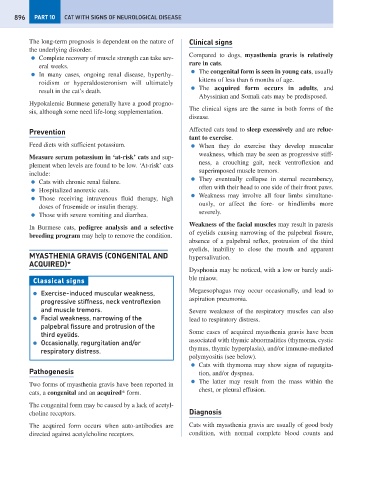Page 904 - Problem-Based Feline Medicine
P. 904
896 PART 10 CAT WITH SIGNS OF NEUROLOGICAL DISEASE
The long-term prognosis is dependent on the nature of Clinical signs
the underlying disorder.
Compared to dogs, myasthenia gravis is relatively
● Complete recovery of muscle strength can take sev-
rare in cats.
eral weeks.
● The congenital form is seen in young cats, usually
● In many cases, ongoing renal disease, hyperthy-
kittens of less than 6 months of age.
roidism or hyperaldosteronism will ultimately
● The acquired form occurs in adults, and
result in the cat’s death.
Abyssinian and Somali cats may be predisposed.
Hypokalemic Burmese generally have a good progno-
The clinical signs are the same in both forms of the
sis, although some need life-long supplementation.
disease.
Prevention Affected cats tend to sleep excessively and are reluc-
tant to exercise.
Feed diets with sufficient potassium. ● When they do exercise they develop muscular
weakness, which may be seen as progressive stiff-
Measure serum potassium in ‘at-risk’ cats and sup-
ness, a crouching gait, neck ventroflexion and
plement when levels are found to be low. ‘At-risk’ cats
superimposed muscle tremors.
include:
● They eventually collapse in sternal recumbency,
● Cats with chronic renal failure.
often with their head to one side of their front paws.
● Hospitalized anorexic cats.
● Weakness may involve all four limbs simultane-
● Those receiving intravenous fluid therapy, high
ously, or affect the fore- or hindlimbs more
doses of frusemide or insulin therapy.
severely.
● Those with severe vomiting and diarrhea.
Weakness of the facial muscles may result in paresis
In Burmese cats, pedigree analysis and a selective
of eyelids causing narrowing of the palpebral fissure,
breeding program may help to remove the condition.
absence of a palpebral reflex, protrusion of the third
eyelids, inability to close the mouth and apparent
MYASTHENIA GRAVIS (CONGENITAL AND hypersalivation.
ACQUIRED)*
Dysphonia may be noticed, with a low or barely audi-
ble miaow.
Classical signs
Megaesophagus may occur occasionally, and lead to
● Exercise-induced muscular weakness,
aspiration pneumonia.
progressive stiffness, neck ventroflexion
and muscle tremors. Severe weakness of the respiratory muscles can also
● Facial weakness, narrowing of the lead to respiratory distress.
palpebral fissure and protrusion of the
Some cases of acquired myasthenia gravis have been
third eyelids.
associated with thymic abnormalities (thymoma, cystic
● Occasionally, regurgitation and/or
thymus, thymic hyperplasia), and/or immune-mediated
respiratory distress.
polymyositis (see below).
● Cats with thymoma may show signs of regurgita-
Pathogenesis tion, and/or dyspnea.
● The latter may result from the mass within the
Two forms of myasthenia gravis have been reported in
chest, or pleural effusion.
cats, a congenital and an acquired* form.
The congenital form may be caused by a lack of acetyl-
choline receptors. Diagnosis
The acquired form occurs when auto-antibodies are Cats with myasthenia gravis are usually of good body
directed against acetylcholine receptors. condition, with normal complete blood counts and

